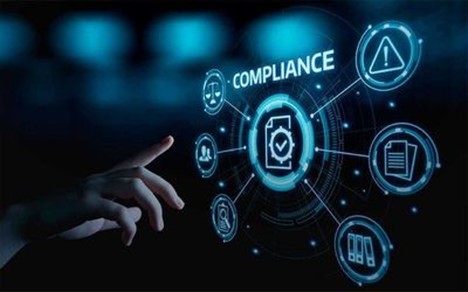In an era marked by rapid technological advancements, the fusion of Artificial Intelligence (AI) with regulatory compliance, known as RegTech, is reshaping industries and ensuring adherence to ever-evolving regulatory landscapes. This article explores the diverse use cases of AI in regulatory compliance, spanning financial services, healthcare, manufacturing, and the energy sector. We’ll delve into the benefits, implementation challenges, and best practices associated with deploying AI in regulatory compliance.
Use Cases of AI in Regulatory Compliance:
1. Regulatory Change Management:
Managing regulatory changes in a global and dynamic landscape is a daunting task. AI plays a pivotal role by instantly notifying companies about necessary adjustments to policies and procedures, streamlining compliance, and influencing the creation of clearer regulations.
2. Regulatory Data Validation:
AI ensures data accuracy by cross-checking transactional data against internal systems and regulatory standards, providing an added layer of data integrity assurance.
3. Trade Surveillance:
AI significantly reduces false alarms in trade and communication surveillance by distinguishing genuine threats from benign activities. It evolves to outpace innovative circumvention methods.
4. AI Testing:
The efficacy of AI in regulatory settings relies on rigorous testing. AI models undergo thorough regression testing to confirm their continued efficacy, ensuring they accurately mirror various scenarios.
5. Data Quality Management:
AI evaluates data completeness, accuracy, and representation. It navigates inconsistencies across regulations, adapts to dynamic rules, and ensures top-tier data quality.
6. Regulatory Analysis by Supervisory Authorities:
AI aids supervisory bodies in oversight roles, swiftly scouring vast amounts of data to flag potential compliance issues or discern emerging risk trends.
7. KYC and Client Onboarding:
AI is transforming Know Your Customer (KYC) and client onboarding processes by analyzing large datasets for a precise understanding of a client’s KYC profile, efficiently detecting fraudulent activities.
8. Data Classification and Audit Trails:
AI allows organizations to automatically sort and label information based on specific criteria, adhering to compliance standards. It generates detailed audit trails, showcasing compliance to oversight bodies.
9. Enhancing Cybersecurity and Regulatory Compliance:
AI contributes to cybersecurity by simulating cyber threats, allowing organizations to assess and enhance their preparedness. It plays a crucial role in fortifying defenses and identifying vulnerabilities.
10. Fraud Detection:
Financial institutions leverage AI, especially machine learning, to detect and prevent fraudulent activities, enhancing the identification of illicit financial activities.
11. Anti-Money Laundering (AML) Efforts:
AI assists in combating money laundering by tracking customers’ transaction habits, identifying unusual financial patterns, and predicting potential threats.
Use Cases Across Major Industry Verticals:
1. Financial Services:
- AI addresses challenges in regulatory change management, reduces false positives, prevents fraud, and mitigates human errors.
2. Healthcare:
- AI ensures software compliance, monitors data privacy, protects against HIPAA violations, updates policies, and controls data access.
3. Manufacturing:
- AI enhances compliance through quality control, maintenance, asset management, and competitive positioning.
4. Energy Sector:
- AI manages carbon emissions, decentralizes grid management, monitors renewables, and ensures data management and security compliance.
Benefits of Using AI for Compliance:
- Reduced False Positives:
- AI refines alert systems, reducing false alarms and operational inefficiencies.
- Cost Efficiency:
- AI processes and analyzes data more efficiently, reducing the need for extensive human capital and resulting in cost savings.
- Minimizing Human Error:
- AI acts as a check against human errors, identifying patterns and trends that may be overlooked by human analysts.
- Enhanced Governance:
- AI streamlines governance processes, expediting change management and reducing costs.
- Streamlined SAR Writing:
- AI accelerates the process of drafting Suspicious Activity Reports (SARs) by identifying suspicious activities and creating comprehensive reports.
- Revamped Ongoing Monitoring:
- AI redefines logic in screening and monitoring tools, reducing false alerts and fostering more dynamic, ongoing due diligence models.
Implementation Challenges of AI for Regulatory Compliance:
- Bias and Discrimination:
- AI algorithms can reflect biases if not critically assessed, jeopardizing compliance and reputation.
- Data Privacy:
- AI’s data-centric nature raises concerns about complying with data privacy regulations and safeguarding against breaches.
- Security Vulnerabilities:
- Advanced capabilities of AI present opportunities for misuse and criminal activities, requiring continuous security training and vigilant monitoring.
- Antitrust Implications:
- Unchecked or unethical use of AI can lead to anti-competitive practices, emphasizing the need for businesses to be conscious of potential antitrust violations.
Best Practices for Deploying AI for Regulatory Compliance:
- Adopt a Holistic View:
- Implement a holistic strategy for AI compliance, considering diverse regulatory demands and ensuring consistent procedures.
- Stay Updated:
- Proactively monitor and understand changes in the AI compliance landscape to anticipate potential impacts.
- Map AI Compliance Requirements:
- Use mapping tools to pinpoint AI compliance requirements, prioritize tasks, and ensure full compliance across multiple jurisdictions.
- Invest in Training and Process Enablement:
- Invest in training programs to empower employees to understand AI compliance objectives and their role in achieving them.
- Promote a Positive AI Compliance Culture:
- Foster a positive compliance culture by building trust, and transparency, and emphasizing the value of AI compliance.
- Implement Robust Data Management Practices:
- Establish clear data governance protocols, regularly audit AI models for biases, and ensure trustworthy and ethically sourced data.
- Engage with Regulators and Industry Groups:
- Actively participate in discussions with regulatory bodies and industry groups to gain insights into upcoming changes and best practices.
Conclusion:
The transformative potential of AI in regulatory compliance is evident across industries. AI not only streamlines processes reduces costs, and enhances efficiency but also ensures organizations remain on the right side of regulatory guidelines. However, responsible AI use, ethical considerations, and adherence to regulatory standards are crucial. As industries navigate this uncharted territory, the goal remains clear: harnessing AI’s prowess while staying anchored to the foundational principles of legality, ethics, and transparency. The future of compliance is not just about adaptation but about evolving with both precision and purpose. Ready to elevate your compliance journey? Dive into the future with AI-driven regulatory compliance solutions, ensuring your business remains steps ahead of the curve.

